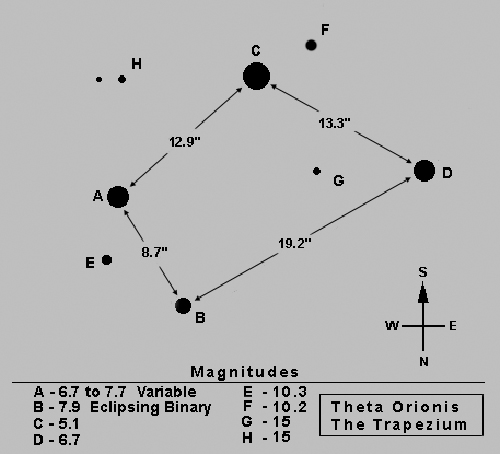
A recurring theme of destruction, upheaval, birth and rebirth occurs within the spiral arms of galaxies. HII regions within the spiral arms of galaxies serve as celestial recycling stations where the birth of new stars completes a great cycle, creating and recycling matter, ultimately enriching and replenishing the interstellar medium with heavier elements. These heavier elements may potentially become the building blocks of terrestrial planets and ultimately living organisms. The Orion Nebula is arguably the greatest of all HII clouds visible from our location within the Milky Way. With a gaseous repository of 10,000 suns, and illuminated by a cluster of hot young stars, the clouds of M42 glow with fantastic colors and shapes, giving us a birds eye view of one of the greatest star forming nurseries in our part of the galaxy.
The radiance and beauty of Orion transcends dry astronomical facts, however the history as well as the physics and chemistry of the Orion Nebula is a tale worthy of telling that helps us understand the nebula's great significance. M42 is a complex cloud of glowing gas, mostly hydrogen but also helium, carbon, nitrogen, and oxygen in decreasing amounts. Although a true astronomical icon, M42 is essentially a bright condensation of the Orion A Molecular Cloud which extends far beyond the Orion Nebula. Although it spans 40 light years, the ionized gas of M42 is an exceptionally thin blister only 0.08 light years thick on the surface of the larger and optically invisible molecular cloud.
Directly in front of M42 is a small grouping of hot O and B type stars known as the trapezium which shine between 5th and 8th magnitude. This grouping represents the 4 brightest members of an extended cluster of several thousand young stars many of which lie unseen within the opaque gas and dust. The bright trapezium grouping represents the cluster core where stars are packed so tight they exceed the stellar concentration of our suns vicinity some 20,000 times. Stars within the trapezium are separated by only 0.12 light years whereas our sun's nearest neighbor is 4 light years away.
The thin blister of ionized gas we call the orion nebula would be invisible if not for the four trapezium stars which together produce all of the ultraviolet radiation illuminating the nebula. The trapezium stars, also called the theta-1 group, are classified from west to east as theta 1A, B, C, and D ( spectral classes B1, B0, O6, B0.5) all located within a tight space spanning only 10,000 astronomical units. The trapezium stars are about 1 million years old and number 4 bright stars. Actually the number is 11 taking into consideration that all members are multiple star systems. If one includes stars seen at only infrared wavelength then the trapezium cluster probably contains over 500 young stars. The highly visible cluster members are hot, massive O and B type stars. All contribute energy to the massive nebula however Theta-1 C, a massive O6 giant, is by far the most prodigious contributor, supplying more than 99% of the ultraviolet energy. Theta-1 C is an enormous star of 40 solar masses and a surface temperature of 40,000 degrees Kelvin. If the earth were located within the trapezium cluster the night sky would be dominated by extraordinarily bright stars. Theta-1 C would shine 10 times brighter than the full moon and the other trapezium members would be at least as bright as the full moon.
The other three members of the trapezium are far less dominant although each weighs in at over 10 solar masses. Amazingly Theta-1 C is 210,000 times more luminous than our sun and produces a gargantuan stellar wind 100,000 times the flow rate of our sun. High resolution images taken by HST show that theta 1C's powerful winds are evaporating dusty disks which surround newly formed stars in the vicinity. These disks might have been the precursors of new planets but will not likely survive the harsh environment imposed by the massive star. Theta-1 C will in all likelihood meet its fate as a great supernova in a few million years.
